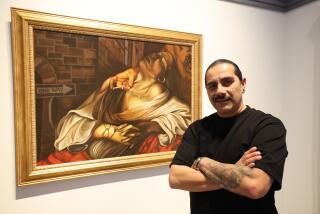Ancient Maya pyramid yields new treasures
“The Storm God enters the sky.”
That’s the translation of Och Chan Yopaat, the name of an ancient Maya ruler whose likeness dominates a remarkable carving discovered last month in a Guatemala pyramid.
The carving, which depicts the ruler atop a mountain spirit, provides important clues about changes in power as Maya groups warred against each other, said Francisco Estrada-Belli, an archaeologist at Tulane and Boston universities.
Estrada-Belli stumbled upon the wall art while exploring the innards of a pyramid that was encased within another pyramid.
The carving dates to the ‘90s — the 590s, that is — and is located in the town of Holmul in the Peten region of Guatemala, part of the ancient Maya lowlands. Maya civilization thrived from around 800 BC to 850 AD in Holmul, which was the site of ongoing strife between warring groups, such as the Kanul and the people of Tikal.
Estrada-Belli, a Guatemalan who grew up in Italy, has been interested in uncovering the region’s history ever since he visited Tikal, a major Maya archaeological site, with his parents at age 7.
“I was completely mesmerized,” he said of his childhood experience. “My father tells me when I went back to school in Italy, I started drawing pyramids and the teacher was quite surprised. She wondered, ‘What happened to this kid?’ But ever since, I’ve been reading nothing but archaeology books.”
In 2000, with his doctorate under his belt, Estrada-Belli opened up a cold case in archaeology. The Holmul ruins had been discovered in 1911 by Harvard archaeologist Raymond Merwin but neglected ever since, according to Estrada-Belli. With backing from the National Geographic Society, Estrada-Belli set out to pick up where Merwin had left off.
“I wanted to go somewhere where there hadn’t been much done,” he said.
Last year, Estrada-Belli and his team excavated one of the site’s pyramids and found a tomb with the bones of a single adult male whose teeth had jade fillings. The tomb was also filled with 28 ceramic vessels, which perhaps signified that the corpse had once been a local ruler.
Walking up a staircase from the tomb, the team stumbled on the carving, which stretched more than 26 feet across the wall and was well over 6 feet tall.
It was made of a limestone-and-water stucco and was painted in red (a pigment that came from local iron ore) with flourishes of blue, green and yellow. It depicted three humans, all wearing bird headdresses and sitting cross-legged on top of the head of a mountain spirit called witz.
Mr. The Storm God Enters the Sky sat in the middle, obviously a person of some great importance, with two feathered serpents slithering below.
Estrada-Belli thinks the three figures are all former rulers. The inscription on the carving refers to the actions of a king named Ajwosaj, who was part of the nearby Naranjo kingdom believed to rule over Holmul at the time. The inscription also indicated that the Naranjo had restored order, implying that Holmul had been in the hands of invaders, Estrada-Belli said.
The artwork provides key clues for the effort to reconstruct the dynamic power grabs that took place throughout this era, he added.
Estrada-Belli called the finding “overwhelming.” He is working to protect and preserve the carving through a nonprofit organization he runs called the Maya Archaeology Initiative. The entire site is in a forest on protected lands, which should ensure that the buried treasures remain safe for the next set of pyramid sketchers.
Return to Science Now.
Follow on Twitter: @BradBalukjian






